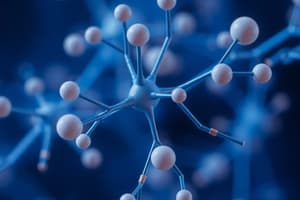Podcast
Questions and Answers
What condition is commonly associated with muscle spasticity, particularly in cases such as multiple sclerosis?
What condition is commonly associated with muscle spasticity, particularly in cases such as multiple sclerosis?
- Parkinson's Disease
- Alzheimer's Disease
- Huntington's Disease
- Cerebral Palsy (correct)
Amnesia refers to the loss of which cognitive function?
Amnesia refers to the loss of which cognitive function?
- Language comprehension
- Memory (correct)
- Motor skills
- Emotional regulation
Which of the following medical procedures typically requires the use of premedication with short acting agents?
Which of the following medical procedures typically requires the use of premedication with short acting agents?
- Electrocardiogram
- Angioplasty (correct)
- Magnetic Resonance Imaging
- Cardiac Stress Test
In which condition is muscle spasticity particularly notable?
In which condition is muscle spasticity particularly notable?
What is a common characteristic of short acting agents used for medical procedures like bronchoscopy?
What is a common characteristic of short acting agents used for medical procedures like bronchoscopy?
Which symptom is NOT commonly associated with insomnia?
Which symptom is NOT commonly associated with insomnia?
What psychological state is closely linked to the experience of tension?
What psychological state is closely linked to the experience of tension?
Which of the following symptoms might indicate a more serious condition if persistent?
Which of the following symptoms might indicate a more serious condition if persistent?
Which of the following is least likely to exacerbate feelings of restlessness?
Which of the following is least likely to exacerbate feelings of restlessness?
Which of the following terms best describes the combination of symptoms including insomnia, restlessness, and tension?
Which of the following terms best describes the combination of symptoms including insomnia, restlessness, and tension?
Which of the following barbiturates is classified as an ultra short acting drug?
Which of the following barbiturates is classified as an ultra short acting drug?
What is the primary clinical use of Phenobarbitone?
What is the primary clinical use of Phenobarbitone?
Which condition is NOT treated with Phenobarbitone?
Which condition is NOT treated with Phenobarbitone?
What action do barbiturates have on glutamate receptors?
What action do barbiturates have on glutamate receptors?
Which of the following barbiturates is used for emergency seizure control?
Which of the following barbiturates is used for emergency seizure control?
Which of the following medications is classified as a benzodiazepine?
Which of the following medications is classified as a benzodiazepine?
What is a common use for the benzodiazepine class of medications?
What is a common use for the benzodiazepine class of medications?
Which of the following is NOT a benzodiazepine?
Which of the following is NOT a benzodiazepine?
What effect do benzodiazepines most commonly produce?
What effect do benzodiazepines most commonly produce?
Which benzodiazepine is known for its long half-life?
Which benzodiazepine is known for its long half-life?
What primary role did the treatments formerly serve in medical practice?
What primary role did the treatments formerly serve in medical practice?
What is a significant reason for the decline in the use of these treatments?
What is a significant reason for the decline in the use of these treatments?
Which alternative treatment has largely replaced the former sedation treatments?
Which alternative treatment has largely replaced the former sedation treatments?
What potential effect might drug enzyme induction have on patients?
What potential effect might drug enzyme induction have on patients?
Which of the following is not considered a characteristic associated with the former sedative treatments?
Which of the following is not considered a characteristic associated with the former sedative treatments?
What is a characteristic effect of benzodiazepines on sleep onset?
What is a characteristic effect of benzodiazepines on sleep onset?
Which statement about benzodiazepines and sleep is accurate?
Which statement about benzodiazepines and sleep is accurate?
What effect do benzodiazepines have on non-REM sleep?
What effect do benzodiazepines have on non-REM sleep?
Which of the following is a common misconception about benzodiazepines?
Which of the following is a common misconception about benzodiazepines?
Which statement is true regarding the effects of benzodiazepines on sleep architecture?
Which statement is true regarding the effects of benzodiazepines on sleep architecture?
Flashcards
Muscle Spasticity
Muscle Spasticity
Increased muscle tone and stiffness, often seen in multiple sclerosis and cerebral palsy.
Amnesia
Amnesia
Loss of memory.
Premedication (Endoscopy/Bronchoscopy)
Premedication (Endoscopy/Bronchoscopy)
Using short-acting drugs before endoscopic or bronchoscopic procedures, and angioplasty.
Angioplasty
Angioplasty
Signup and view all the flashcards
Short-acting agent
Short-acting agent
Signup and view all the flashcards
Benzodiazepine effect
Benzodiazepine effect
Signup and view all the flashcards
Hypnotic effect
Hypnotic effect
Signup and view all the flashcards
Sleep latency
Sleep latency
Signup and view all the flashcards
Non-REM sleep stage 2
Non-REM sleep stage 2
Signup and view all the flashcards
Benzodiazepines and Sleep
Benzodiazepines and Sleep
Signup and view all the flashcards
Benzodiazepines
Benzodiazepines
Signup and view all the flashcards
Diazepam
Diazepam
Signup and view all the flashcards
Clonazepam
Clonazepam
Signup and view all the flashcards
Chlordiazepoxide
Chlordiazepoxide
Signup and view all the flashcards
Flurazepam
Flurazepam
Signup and view all the flashcards
Restlessness
Restlessness
Signup and view all the flashcards
Insomnia
Insomnia
Signup and view all the flashcards
Tension
Tension
Signup and view all the flashcards
Pharmacology
Pharmacology
Signup and view all the flashcards
CNS
CNS
Signup and view all the flashcards
Sedative Replacement
Sedative Replacement
Signup and view all the flashcards
Enzyme Induction (Sedatives)
Enzyme Induction (Sedatives)
Signup and view all the flashcards
Benzodiazepines' Benefits
Benzodiazepines' Benefits
Signup and view all the flashcards
Older Sedative Drawbacks
Older Sedative Drawbacks
Signup and view all the flashcards
Why Replace Sedatives?
Why Replace Sedatives?
Signup and view all the flashcards
Thiopental
Thiopental
Signup and view all the flashcards
Phenobarbital
Phenobarbital
Signup and view all the flashcards
Barbiturate receptor blocking
Barbiturate receptor blocking
Signup and view all the flashcards
Status Epilepticus
Status Epilepticus
Signup and view all the flashcards
Eclampsia
Eclampsia
Signup and view all the flashcards
Study Notes
Anxiolytic and Hypnotic Drugs
- Benzodiazepines are widely used anxiolytic drugs—safe and effective.
- Mechanism of action: Benzodiazepines act on γ-aminobutyric acid (GABA) receptors. GABA is the major inhibitory neurotransmitter in the central nervous system (CNS).
- GABA receptors are composed of five subunits (α, β, and γ) that span the postsynaptic membrane.
- Binding of GABA to its receptor triggers the opening of the central ion channel, allowing chloride ions to pass through the pore.
- Chloride influx causes hyperpolarization of the neuron and decreases neurotransmission by inhibiting the formation of action potentials.
- Benzodiazepines enhance the binding of GABA, increasing chloride influx and the inhibitory effect.
Therapeutic Uses
- Anxiety disorders, depression, and schizophrenia: These drugs are not for everyday stress; rather, for severe anxiety, short-term use is recommended; they have less tolerance than sedatives or hypnotics; long-acting agents are better than short-acting due to less abrupt withdrawal reactions.
- Muscle disorders: Diazepam is useful for muscle spasms (e.g., muscle strains). It is effective for muscle spasticity in conditions like multiple sclerosis and cerebral palsy.
- Premedication for endoscopic and bronchoscopy procedures: Short-acting agents are best.
- Seizures: Diazepam is used in grand mal seizures, status epilepticus, and acute alcohol withdrawal. Clonazepam is used for absence epilepsy.
- Sleep disorders: Benzodiazepines have sedative and calming effects but not all have hypnotic effects. They reduce sleep latency and increase stage 2 non-REM sleep.
Classification of Benzodiazepines
- Long-acting: Diazepam, clonazepam, chlordiazepoxide, clorazepate, flurazepam.
- Intermediate-acting: Lorazepam, alprazolam, temazepam.
- Short-acting: Triazolam, midazolam, oxazepam.
Dependence
- High doses can cause prolonged psychological and physical dependence.
- Withdrawal symptoms include confusion, anxiety, agitation, restlessness, insomnia, and tension.
Adverse Effects
- Common: Drowsiness and confusion (more pronounced at higher doses), ataxia.
- Precaution: Avoid in liver disease, acute narrow-angle glaucoma, alcohol/CNS depressant interaction, and pregnancy/breastfeeding.
Other Anxiolytic and Hypnotic Agents
- Zolpidem: Not a benzodiazepine, acts on BZ receptors, short acting, less rebound withdrawal.
- Hydroxyzine: Antihistamine with antiemetic and sedative effects; used prior to surgery.
Benzodiazepine Antagonist
- Flumazenil: GABA receptor antagonist that rapidly reverses benzodiazepine effects. Short half-life; repeated doses needed for sustained reversal.
Barbiturates
- Previously mainstay for sedation and sleep maintenance—now largely replaced by benzodiazepines.
- Problems: Enzyme induction, tolerance, physical dependence, severe withdrawal, and a narrow safety margin.
- Mechanism of action: Interact with GABA receptors to enhance GABAergic transmission; block excitatory glutamate receptors.
- Examples: Thiopental (ultra-short acting), Phenobarbital (long-acting), used for anesthesia induction, convulsive disorders.
Non-barbiturate Sedatives
- Chloral hydrate: Prodrug, converted to trichloroethanol, effective as a sedative/hypnotic, irritating to the gut, epigastric distress.
Antihistamines
- Diphenhydramine: Sedative properties, mild insomnia.
- Chlorpheniramine: Other antihistamines.
Ethanol
- Anti-anxiety and sedative effects, serious toxic potential.
- Chronic use leads to liver disease, gastritis, and nutritional deficiency.
- Cardiotoxicity is a risk in heavy drinkers.
- Benzodiazepines are the preferred therapy for alcohol withdrawal.
Disulfiram
- Blocks the oxidation of acetaldehyde to acetic acid.
- Causes acetaldehyde accumulation, leading to flushing, tachycardia, hyperventilation, and nausea.
- Used in patients wanting to stop alcohol consumption.
Buspirone
- Anti-anxiety partial agonist at serotonin receptors, does not cause dependence. It does not work on the GABA system.
Melatonin
- Secreted by the pineal gland. Promotes sleep; Ramelteon is a melatonin receptor agonist.
- Side effects include gastrointestinal disturbances.
Studying That Suits You
Use AI to generate personalized quizzes and flashcards to suit your learning preferences.





